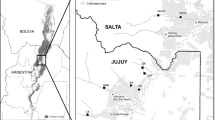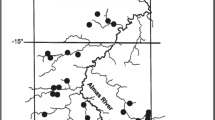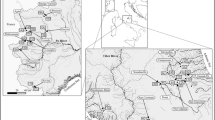Abstract
The present study focuses on the role ofenvironmental factors in plant diversity and community organization at both water-body and river floodplain levels. The cover of each plant species was measured at 841 sampling plots along 63 cut-off channels located in four river floodplains. Environmental variables were documented either at river level (suspended matter, water physico-chemistry, river slope) or at cut-off channel level (channel capacity, slope, substrate grain-size). At both river and cut-off channel levels, increasing slope (i.e. increasing erosion during floods) and decreasing nutrient-content of the water raise species richness and uniqueness (number of species found only in one river), according to hypotheses on the combined role of disturbances and productivity in biodiversity. Rivers that are not eroded during floods are nutrient-rich and present the lowest richness and uniqueness at the river level, but dewatering combined with high connectivity increase richness at the cut-off channel level.
Similar content being viewed by others
References
Amoros C andBornette G (1999) Antagonist and cumulative effects of connectivity: a predictive model based on aquatic vegetation in riverine cut-off channels. Archiv für Hydrobiologie, Suppl 115/3: 311–327
Amoros C,Bornette G andHenry CP (2000) A vegetation-based method for the ecological diagnosis of riverine cut-off channels. Environmental Management 25: 211–227
Amoros C,Rostan JC,Pautou G andBravard JP (1987) The reversible process concept applied to the environmental management of large rivers systems. Environmental Management 11: 607–617
Barrat-Segretain MH (1996) Germination and colonisation dynamics of Nuphar lutea (L.) Sm. in a former river channel. Aquatic Botany 55: 31–38
Bendix J (1999) Stream power influence on southern Californian riparian vegetation. Journal of Vegetation Science 10: 243–252
Bilby R (1977) Effects of a spate on the macrophyte vegetation of a stream pool. Hydrobiologia 56: 109–112
Boar RR andCrook CE (1985) Investigations into the causes of reedswamp regression in the Norfolk Broads. Verhandlungen der Internationale Vereinigung für Limnologie 22: 2916–2919
Bornette G andAmoros C (1991) Aquatic vegetation and hydrology of a braided river floodplain. Journal of Vegetation Science 2: 497–512
Bornette G andAmoros C (1996) Disturbance regimes and vegetation dynamics: role of floods in riverine wetlands. Journal of Vegetation Science 7: 615–622
Bornette G,Amoros C andLamouroux N (1998) Aquatic plant diversity in riverine wetlands: the role of connectivity. Freshwater Biology 39: 267–283
Braun-Blanquet J (1932) Plant sociology: the study of plant communities. Transl. G.D. Fuller and H.S. Conard, Mc Graw Hill Book, New York
Bravard JC andGilvear DJ (1996) Hydrological and geomophological structure of hydrosystems. In: Petts G andAmoros C (eds) Fluvial Hydrosystems, pp 98–116. Chapman & Hall, London
Bravard JP (1987) Le RhÔne, du Léman à Lyon. La Manufacture, Lyon
Bravard JP,Amoros C andPautou G (1986) Impact of civil engineering works on the successions of communities in a fluvial system. Oikos 47: 92–111
Carbiener R,Trémolières M,Mercier JL andOrtscheit A (1990) Aquatic macrophyte communities as bioindicators of eutrophication in calcareous oligosaprobe stream waters (Upper Rhine plain, Alsace). Vegetatio 86: 71–88
Castella E,Richardot-Coulet M,Roux C andRichoux P (1991) Aquatic macroinvertebrate assemblages of two contrasting floodplains: the Rhone and Ain rivers, France. Regulated Rivers, Research and Management 6: 289–300
Chapman VJ,Brown JMA,Hill CF andCarr JL (1974) Biology of excessive weed growth in the hydroelectric lakes of the Waikato River, New Zealand. Hydrobiologia 44: 349–363
Connell JH (1978) Diversity in tropical rain forests and coral reefs. Science 199: 1302–1310
Gilvear DJ andBravard JC (1996) Geomorphology of temperate rivers. In: Petts G andAmoros C (eds) Fluvial Hydrosystems, pp 68–97. Chapman & Hall, London
Haslam SM (1982) Major factors determining the distribution of macrophytic vegetation in the watercourses of the European economic community. Proceedings EWRSGH Symposium on Aquatic Weeds, pp 105–111
Henry C,Amoros C andBornette G (1996) Species traits and recolonization processes after flood disturbance in riverine macrophytes. Vegetatio 122: 13–27
Henry C,Bornette G andAmoros C (1994) Differencial effects of floods on the aquatic vegetation of braided channels of the RhÔne River. Journal of the North American Benthological Society 13: 439–467
Hills NM,Keddy PA andWisheu IC (1998) A hydrological model for predictiong the effects of dams on the shoreline vegetation of lakes and reservoirs. Environmental Management 22: 723–736
Hough RA,Fornwall MD,Negele BJ,Thompson RL andPutt DA (1989) Plant community dynamics in a chain of lakes: principal factors in the decline of rooted macrophytes with eutrophication. Hydrobiologia 173: 199–217
Hupp CR (1992) Riparian vegetation recovering patterns following stream channelization: a geomorphic perspective. Ecology 73: 1209–1226
Hupp CR andOsterkamp WR (1985) Bottomland vegetation distribution along Passage Creek, Virginia, in relation to fluvial landforms. Ecology 66: 670–681
Huston M (1979) A general hypothesis of species diversity. American Naturalist 113: 81–101
Kalliola R,Salo J,Puhakka M andRajasilta M (1991) New site formation and colonizing vegetation in primary succession on the western Amazon floodplains. Journal of Ecology 79: 877–901
Kohler A,Brinkmeier R andVollrath H (1974) Verbreitung und Indikatorwert der submersen Makrophyten in den Fließgewässern der Friedberger Au. Bericht der Bayerischen botanischen Gesellschaft zür Erforschung der heimischen Flora 45: 5–36
Kooijman AM andBakker C (1995) Species replacement in the bryophyte layer in mires: the role of water type, nutrient supply and interspecific interactions. Journal of Ecology 83: 1–8
Lamberti GA,Gregory SV,Ashkenas LR,Wildman RC andMoore KMS (1991) Stream water-body recovery following a catastrophic debris flow. Canadian Journal of Fisheries and Aquatic Sciences 48: 196–207
Müller N (1995) River dynamics and floodplain vegetation and their alterations due to human impact. Archiv für Hydrobiologie (Suppl 101 Large Rivers) 9(3/4): 477–512
Menges ES andWaller DM (1983) Plant strategies in relation to elevation and light in floodplain herbs. American Naturalist 122: 454–473
Phillips GL,Eminson D andMoss B (1978) A mechanism to account for macrophyte decline in progressively eutrophicated freshwaters. Aquatic Botany 4: 103–126
Piegay H,Bornette G,Citterio A,Herouin E,Moulin B andStratiotis C (2000) Channel instability as a control factor of silting dynamics and vegetation pattern within perifluvial aquatic zones. Hydrological Processes 14: 3011–3029
Poff LN andWard JV (1990) Physical habitat template of lotic systems: recovery in the context of historical pattern of spatiotemporal heterogeneity. Environmental Management 14: 629–645
Pollock MM,Naiman RJ andHanley TA (1998) Plant species richness in riparian wetlands-a test of biodiversity theory. Ecology 79: 94–105
Resh VH,Brown AV,Covich AP,Sheldon AL,Wallace JB andWissman RC (1988) The role of disturbance in stream hydrology. Journal of the North American Benthological Society 7: 433–455
Robach F,Eglin I andTrémolières M (1997) Species richness of aquatic macrophytes in former channels connected to a river: a comparison between two fluvial hydrosystems differing in their regime and regulation. Global Ecology and Biogeography Letters 6: 267–274
Robertson KM andAugspurger CK (1999) Geomorphic processes and spatial patterns of primary forest succession on the Bogue Chitto River, USA. Journal of Ecology 87: 1052–1063
Shelford VE (1954) Some lower Mississippi valley flood plain biotic communities; their age and elevation. Ecology 35: 126–142
Sørensen TA (1948) A method of establishing groups of equal amplitude in plant sociology based on similarity of species content and its application to analyses of the vegetation of Danish commons. Det Kongelige Danske Videnskabernes Selskab Biologiske Skrifter 5: 1–34
Sousa WP (1984) The role of disturbance in natural communities. Annual Reveiws of Ecology and Systematics 15: 353–391
Southwick CH andPine FW (1975) Abundance of submerged vegetation in the Rhode River from 1966 to 1973. Chesapeake Science 16: 147–151
Thioulouse J,Dolédec S,Chessel D andOlivier JM (1997) ADE-4: a multivariate analysis and graphical display software. Statistics and Computing 7: 75–83
van Dijk HWJ andGrootjans AP (1993) Wet dune slack: decline and new opportunities. Hydrobiologia 265: 281–304
Ward JV,Tockner K andSchiemer F (1999a) Biodiversity of floodplain river ecosystems: ecotones and connectivity. Regulated Rivers 15: 125–139
Ward JV,Tockner K,Edwards PJ,Kollman J,Bretschko G,Gurnell AM,Petts GE andRossaro B (1999b) A reference river system for the Alps: the 'Fiume Tagliamento'. Regulated Rivers 15: 63–75
Wassen MJ,Barendregt A,Palczynski A,De Smidt JT andDe Mars H (1990) The relationship between fen vegetation gradients, groundwater flow and flooding in an undrained valley mire at Biebrza, Poland. Journal of Ecology 78: 1106–1122
White PS andPickett STA (1985) Natural disturbance and patch dynamics: an introduction. In: Pickett STA andWhite PS (eds) The Ecology of Natural Disturbance and Patch Dynamics, pp 3–13. Academic Press, Orlando, Florida
Wood PJ andArmitage PD (1997) Biological effects of fine sediment in the lotic environment. Environmental Management 21: 203–217
Zobel M,van der Maarel E andDupré C (1998) Species pool: the concept, its determination and significance for community restoration. Applied Vegetation Science 1: 55–66
Author information
Authors and Affiliations
Rights and permissions
About this article
Cite this article
Bornette, G., Piegay, H., Citterio, A. et al. Aquatic plant diversity in four river floodplains: a comparison at two hierarchical levels. Biodiversity and Conservation 10, 1683–1701 (2001). https://doi.org/10.1023/A:1012090501147
Issue Date:
DOI: https://doi.org/10.1023/A:1012090501147




